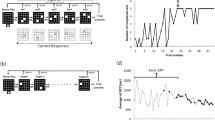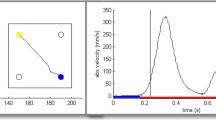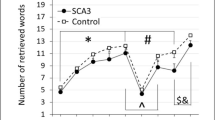Abstract
Introduction
Procedural perceptual-motor learning of sequences (PPMLS) provides perceptual-motor skills in many activities of daily living. Based on behavioral and neuroimaging results, theoretical models of PPMLS postulate that the cortico-striatal loop, the cortico-cerebellar loop and the hippocampus are specifically involved in the early stage of PPMLS while the cortico-striatal loop would be specifically involved in the late stage of PPMLS. Hence, current models predict that the early stage of PPMLS should be impaired in Parkinson’s disease (PD: lesion of the cortico-striatal loop), in cerebellar disease (CD: lesion of the cortico-cerebellar loop) and in Alzheimer’s disease (AD: lesion of the hippocampus), whereas the late stage of PPMLS should be specifically impaired in PD.
Objective
The aim of the study is (1) to draw a complete picture of experimental results on PPMLS in PD, CD and AD (2) to understand heterogeneity of results as regard to participant and task characteristics.
Method
This review is based on the guideline proposed by the PRISMA statement.
Results
Our review reveals (1) that the experimental results clarify the theoretical models and (2) that the impairment of PPMLS depends on both the personal characteristics of the participants and the characteristics of the task to-be-learnt rather than on the disease itself.
Conclusion
Our results highlight that these characteristics should be more carefully considered to understand the heterogeneity of results across studies on PPMLS and the effects of rehabilitation programs.


Similar content being viewed by others
References
Eustache F, Viard A, Desgranges B (2016) The MNESIS model: memory systems and processes, identity and future thinking. Neuropsychologia 87:96–109. https://doi.org/10.1016/j.neuropsychologia.2016.05.006
Squire LR, Zola SM (1996) Structure and function of declarative and nondeclarative memory systems. Proc Natl Acad Sci 93(24):13515–13522. https://doi.org/10.1073/pnas.93.24.13515
Milner B, Corkin S, Teuber H-L (1968) Further analysis of the hippocampal amnesic syndrome: 14-year follow-up study of H.M. Neuropsychologia 6(3):215–234. https://doi.org/10.1016/0028-3932(68)90021-3
Tulving E, Markowitsch HJ (1998) Episodic and declarative memory: role of the hippocampus. Hippocampus 8(3):198–204
Doyon J, Laforce R, Bouchard G, Gaudreau D, Roy J, Poirier M, Bouchard J-P (1998) Role of the striatum, cerebellum and frontal lobes in the automatization of a repeated visuomotor sequence of movements. Neuropsychologia 36(7):625–641. https://doi.org/10.1016/S0028-3932(97)00168-1
Cohen N, Squire L (1980) Preserved learning and retention of pattern-analyzing skill in amnesia: dissociation of knowing how and knowing that. Science 210(4466):207–210. https://doi.org/10.1126/science.7414331
Janacsek K, Nemeth D (2012) Predicting the future: from implicit learning to consolidation. Int J Psychophysiol 83(2):213–221. https://doi.org/10.1016/j.ijpsycho.2011.11.012
Reber PJ, Squire LR (1994) Parallel brain systems for learning with and without awareness. Learn Mem 1(4):217–229
Doyon J, Penhune V, Ungerleider LG (2003) Distinct contribution of the cortico-striatal and cortico-cerebellar systems to motor skill learning. Neuropsychologia 41(3):252–262. https://doi.org/10.1016/S0028-3932(02)00158-6
Karni A, Meyer G, Rey-Hipolito C, Jezzard P, Adams MM, Turner R, Ungerleider LG (1998) The acquisition of skilled motor performance: fast and slow experience-driven changes in primary motor cortex. Proc Natl Acad Sci 95(3):861–868. https://doi.org/10.1073/pnas.95.3.861
Karni A (1996) The acquisition of perceptual and motor skills: a memory system in the adult human cortex. Cogn Brain Res 5(1–2):39–48. https://doi.org/10.1016/S0926-6410(96)00039-0
Ammons RB, Farr RG, Bloch E, Neumann E, Dey M, Marion R, Ammons CH (1958) Long-term retention of perceptual-motor skills. J Exp Psychol 55(4):318–328. https://doi.org/10.1037/h0041893
Neumann E, Ammons RB (1957) Acquisition and long-term retention of a simple serial perceptual-motor skill. J Exp Psychol 53(3):159–161. https://doi.org/10.1037/h0041719
Fleishman EA, Parker JF Jr (1962) Factors in the retention and relearning of perceptual-motor skill. J Exp Psychol 64(3):215–226. https://doi.org/10.1037/h0041220
Brown RM, Robertson EM, Press DZ (2009) Sequence skill acquisition and off-line learning in normal aging. PLoS ONE 4(8):e6683. https://doi.org/10.1371/journal.pone.0006683
Howard DV, Howard JH (1989) Age differences in learning serial patterns: Direct versus indirect measures. Psychol Aging 4(3):357–364. https://doi.org/10.1037/0882-7974.4.3.357
Desgranges B (1998) The neural substrates of memory systems impairment in Alzheimer’s disease. A PET study of resting brain glucose utilization. Brain 121(4):611–631. https://doi.org/10.1093/brain/121.4.611
Desgranges B, Eustache F (2011) Les conceptions de la mémoire déclarative d’Endel Tulving et leurs conséquences actuelles. Rev Neuropsychol 3(2):94. https://doi.org/10.3917/rne.032.0094
Cavaco S (2004) The scope of preserved procedural memory in amnesia. Brain 127(8):1853–1867. https://doi.org/10.1093/brain/awh208
Nissen MJ, Bullemer P (1987) Attentional requirements of learning: evidence from performance measures. Cogn Psychol 19(1):1–32. https://doi.org/10.1016/0010-0285(87)90002-8
Robertson EM (2007) The serial reaction time task: implicit motor skill learning? J Neurosci 27(38):10073–10075. https://doi.org/10.1523/JNEUROSCI.2747-07.2007
Romano JC, Howard JH, Howard DV (2010) One-year retention of general and sequence-specific skills in a probabilistic, serial reaction time task. Memory 18(4):427–441. https://doi.org/10.1080/09658211003742680
Doyon J, and Benali H (2005) Reorganization and plasticity in the adult brain during learning of motor skills. In Proceedings. 2005 IEEE International Joint Conference on Neural Networks, 2005. (Vol 3, pp 1523–1524). Presented at the 2005 IEEE International Joint Conference on Neural Networks, 2005., Montreal, QC, Canada: IEEE. https://doi.org/10.1109/IJCNN.2005.1556102
Hikosaka O, Nakamura K, Sakai K, Nakahara H (2002) Central mechanisms of motor skill learning. Curr Opin Neurobiol 12(2):217–222. https://doi.org/10.1016/S0959-4388(02)00307-0
Hallgató E, Győri-Dani D, Pekár J, Janacsek K, Nemeth D (2013) The differential consolidation of perceptual and motor learning in skill acquisition. Cortex 49(4):1073–1081. https://doi.org/10.1016/j.cortex.2012.01.002
Conway CM (2020) How does the brain learn environmental structure? Ten core principles for understanding the neurocognitive mechanisms of statistical learning. Neurosci Biobehav Rev 112:279–299. https://doi.org/10.1016/j.neubiorev.2020.01.032
Hikosaka O, Nakahara H, Rand MK, Sakai K, Lu X, Nakamura K, Doya K (1999) Parallel neural networks for learning sequential procedures. Trends Neurosci 22(10):464–471. https://doi.org/10.1016/S0166-2236(99)01439-3
Janacsek K, Shattuck KF, Tagarelli KM, Lum JAG, Turkeltaub PE, Ullman MT (2020) Sequence learning in the human brain: a functional neuroanatomical meta-analysis of serial reaction time studies. NeuroImage 207:116387. https://doi.org/10.1016/j.neuroimage.2019.116387
Brashers-Krug T, Shadmehr R, Bizzi E (1996) Consolidation in human motor memory. Nature 382(6588):252–255. https://doi.org/10.1038/382252a0
Robertson EM (2009) From creation to consolidation: a novel framework for memory processing. PLoS biology 7(1):e19. https://doi.org/10.1371/journal.pbio.1000019
Walker MP, Brakefield T, Allan Hobson J, Stickgold R (2003) Dissociable stages of human memory consolidation and reconsolidation. Nature 425(6958):616–620. https://doi.org/10.1038/nature01930
Baetens K, Firouzi M, Van Overwalle F, Deroost N (2020) Involvement of the cerebellum in the serial reaction time task (SRT) (Response to Janacsek et al.). NeuroImage 220:117114. https://doi.org/10.1016/j.neuroimage.2020.117114
Clark GM, Lum JAG, Ullman MT (2014) A meta-analysis and meta-regression of serial reaction time task performance in Parkinson’s disease. Neuropsychology 28(6):945–958. https://doi.org/10.1037/neu0000121
Clark GM, Lum JAG (2017) Procedural learning in Parkinson’s disease, specific language impairment, dyslexia, schizophrenia, developmental coordination disorder, and autism spectrum disorders: a second-order meta-analysis. Brain Cogn 117:41–48. https://doi.org/10.1016/j.bandc.2017.07.004
Hayes HA, Hunsaker N, Dibble LE (2015) Implicit motor sequence learning in individuals with Parkinson disease: a meta-analysis. J Parkinson’s Dis 5(3):549–560. https://doi.org/10.3233/JPD-140441
Siegert RJ, Taylor KD, Weatherall M, Abernethy DA (2006) Is implicit sequence learning impaired in Parkinson’s disease? A meta-analysis. Neuropsychology 20(4):490–495. https://doi.org/10.1037/0894-4105.20.4.490
van Halteren-van Tilborg IADA, Scherder EJA, Hulstijn W (2007) Motor-skill learning in Alzheimer’s disease: a review with an eye to the clinical practice. Neuropsychol Rev 17(3):203–212. https://doi.org/10.1007/s11065-007-9030-1
Page MJ, McKenzie JE, Bossuyt PM, Boutron I, Hoffmann TC, Mulrow CD, ... Moher D (2021) The PRISMA 2020 statement: an updated guideline for reporting systematic reviews. Int J Surg88:105906. https://doi.org/10.1136/bmj.n71
Liberati A, Altman DG, Tetzlaff J, Mulrow C, Gøtzsche PC, Ioannidis JPA, Moher D (2009) The PRISMA statement for reporting systematic reviews and meta-analyses of studies that evaluate health care interventions: explanation and elaboration. J Clin Epidemiol 62(10):e1–e34. https://doi.org/10.1016/j.jclinepi.2009.06.006
Dirnberger G, Novak J, Nasel C, Zehnter M (2010) Separating coordinative and executive dysfunction in cerebellar patients during motor skill acquisition. Neuropsychologia 48(5):1200–1208. https://doi.org/10.1016/j.neuropsychologia.2009.12.016
Dirnberger G, Novak J, Nasel C (2013) Perceptual sequence learning is more severely impaired than motor sequence learning in patients with chronic cerebellar stroke. J Cogn Neurosci 25(12):2207–2215. https://doi.org/10.1162/jocn_a_00444
Spencer RMC, Ivry RB (2009) Sequence learning is preserved in individuals with cerebellar degeneration when the movements are directly cued. J Cogn Neurosci 21(7):1302–1310. https://doi.org/10.1162/jocn.2009.21102
Gomez-Beldarrain M, Garcia-Monco JC, Rubio B, Pascual-Leone A (1998) Effect of focal cerebellar lesions on procedural learning in the serial reaction time task. Exp Brain Res 120(1):25–30. https://doi.org/10.1007/s002210050374
Molinari M (1997) Cerebellum and procedural learning: evidence from focal cerebellar lesions. Brain 120(10):1753–1762. https://doi.org/10.1093/brain/120.10.1753
Pascual-Leone A, Grafman J, Clark K, Stewart M, Massaquoi S, Lou J-S, Hallett M (1993) Procedural learning in Parkinson’s disease and cerebellar degeneration. Ann Neurol 34(4):594–602. https://doi.org/10.1002/ana.410340414
Shin JC, Ivry RB (2003) Spatial and temporal sequence learning in patients with Parkinson’s disease or cerebellar lesions. J Cogn Neurosci 15(8):1232–1243. https://doi.org/10.1162/089892903322598175
Tzvi E, Zimmermann C, Bey R, Münte TF, Nitschke M and Krämer UM (2017) Cerebellar degeneration affects cortico-cortical connectivity in motor learning networks. NeuroImage: Clin 16:66–78. https://doi.org/10.1016/j.nicl.2017.07.012
Atkinson J, Braddick O (2011) From genes to brain development to phenotypic behavior: “dorsal-stream vulnerability” in relation to spatial cognition, attention, and planning of actions in Williams syndrome (WS) and other developmental disorders. Prog Brain Res 189:261–283. https://doi.org/10.1016/B978-0-444-53884-0.00029-4
Ferraro FR, Balota DA, Connor LT (1993) Implicit memory and the formation of new associations in nondemented Parkinson’s disease individuals and individuals with senile dementia of the Alzheimer type: a serial reaction time (SRT) investigation. Brain Cogn 21(2):163–180. https://doi.org/10.1006/brcg.1993.1013
Knopman D (1991) Long-term retention of implicitly acquired learning in patients with Alzheimer’s disease. J Clin Exp Neuropsychol 13(6):880–894. https://doi.org/10.1080/01688639108405105
Schmitz X, Bier N, Joubert S, Lejeune C, Salmon E, Rouleau I, Meulemans T (2014) The Benefits of errorless learning for serial reaction time performance in Alzheimer’s disease. J Alzheimer’s Dis 39(2):287–300. https://doi.org/10.3233/JAD-130887
van Tilborg IADA, Hulstijn W (2010) Implicit motor learning in patients with Parkinson’s and Alzheimer’s disease: differences in learning abilities? Mot Control 14(3):344–361. https://doi.org/10.1123/mcj.14.3.344
Willingham DB, Peterson EW, Manning C, Brashear HR (1997) Patients with Alzheimer’s disease who cannot perform some motor skills show normal learning of other motor skills. Neuropsychology 11(2):261–271. https://doi.org/10.1037/0894-4105.11.2.261
Kemény F, Demeter G, Racsmány M, Valálik I, Lukács Á (2019) Impaired sequential and partially compensated probabilistic skill learning in Parkinson’s disease. J Neuropsychol 13(3):509–528. https://doi.org/10.1111/jnp.12163
Sommer M, Grafman J, Clark K, Hallett M (1999) Learning in Parkinson’s disease: eyeblink conditioning, declarative learning, and procedural learning. J Neurol Neurosurg Psychiatry 67(1):27–34. https://doi.org/10.1136/jnnp.67.1.27
Stefanova ED, Kostic VS, Ziropadja L, Markovic M, Ocic GG (2000) Visuomotor skill learning on serial reaction time task in patients with early Parkinson’s disease. Mov Disord 15(6):9
Stephan MA, Meier B, Zaugg SW, Kaelin-Lang A (2011) Motor sequence learning performance in Parkinson’s disease patients depends on the stage of disease. Brain Cogn 75(2):135–140. https://doi.org/10.1016/j.bandc.2010.10.015
Dominey PF, Ventre-Dominey J, Broussolle E, Jeannerod M (1997) Analogical transfer is effective in a serial reaction time task in Parkinson’s disease: evidence for a dissociable form of sequence learning. Neuropsychologia 35(1):1–9. https://doi.org/10.1016/S0028-3932(96)00050-4
Pascual-Leone A, Valls-Sole J, Brasil-Neto JP, Cammarota A, Grafman J, Hallett M (1994) Akinesia in Parkinson’s disease. II. Effects of subthreshold repetitive transcranial motor cortex stimulation. Neurology 44(5):892–892. https://doi.org/10.1212/WNL.44.5.892
Kwak Y, Müller MLTM, Bohnen NI, Dayalu P, Seidler RD (2010) Effect of dopaminergic medications on the time course of explicit motor sequence learning in Parkinson’s disease. J Neurophysiol 103(2):942–949. https://doi.org/10.1152/jn.00197.2009
Meissner SN, Krause V, Südmeyer M, Hartmann CJ and Pollok B (2018) The significance of brain oscillations in motor sequence learning: insights from Parkinson’s disease. NeuroImage: Clin 20:448–457. https://doi.org/10.1016/j.nicl.2018.08.009
Seidler RD, Tuite P, Ashe J (2007) Selective impairments in implicit learning in Parkinson’s disease. Brain Res 1137(1):104–110. https://doi.org/10.1016/j.brainres.2006.12.057
Wang XP, Sun BM, Ding HL (2009) Changes of procedural learning in Chinese patients with non-demented Parkinson disease. Neurosci Lett 449(3):161–163. https://doi.org/10.1016/j.neulet.2008.10.086
Helmuth LL, Mayr U, Daum I (2000) Sequence learning in Parkinson’s disease: a comparison of spatial-attention and number-response sequences. Neuropsychologia 38(11):1443–1451. https://doi.org/10.1016/S0028-3932(00)00059-2
Schmahmann JD, Guell X, Stoodley CJ, Halko MA (2019) The theory and neuroscience of cerebellar cognition. Annu Rev Neurosci 42(1):337–364. https://doi.org/10.1146/annurev-neuro-070918-050258
Ito M (2008) Control of mental activities by internal models in the cerebellum. Nat Rev Neurosci 9(4):304–313. https://doi.org/10.1038/nrn2332
Diedrichsen J, King M, Hernandez-Castillo C, Sereno M, Ivry RB (2019) Universal transform or multiple functionality? Understanding the contribution of the human cerebellum across task domains. Neuron 102(5):918–928. https://doi.org/10.1016/j.neuron.2019.04.021
Knopman DS, Nissen MJ (1987) Implicit learning in patients with probable Alzheimer’s disease. Neurology 37(5):784–784. https://doi.org/10.1212/WNL.37.5.784
Muslimovic D, Post B, Speelman JD, Schmand B (2007) Motor procedural learning in Parkinson’s disease. Brain 130(11):2887–2897. https://doi.org/10.1093/brain/awm211
Deroost N, Kerckhofs E, Coene M, Wijnants G, Soetens E (2006) Learning sequence movements in a homogenous sample of patients with Parkinson’s disease. Neuropsychologia 44(10):1653–1662. https://doi.org/10.1016/j.neuropsychologia.2006.03.021
Meissner SN, Krause V, Südmeyer M, Hartmann CJ and Pollok B (2019) Pre-stimulus beta power modulation during motor sequence learning is reduced in ’Parkinson’s disease. NeuroImage: Clin 24:102057. https://doi.org/10.1016/j.nicl.2019.102057
Vandenbossche J, Deroost N, Soetens E, Coomans D, Spildooren J, Vercruysse S, Kerckhofs E (2013) Impaired implicit sequence learning in Parkinson’s disease patients with freezing of gait. Neuropsychology 27(1):28–36. https://doi.org/10.1037/a0031278
Kelly SW, Jahanshahi M, Dirnberger G (2004) Learning of ambiguous versus hybrid sequences by patients with Parkinson’s disease. Neuropsychologia 42(10):1350–1357. https://doi.org/10.1016/j.neuropsychologia.2004.02.013
Werheid K, Zysset S, Müller A, Reuter M, von Cramon DY (2003a) Rule learning in a serial reaction time task: An fMRI study on patients with early Parkinson’s disease. Cogn Brain Res 16(2):273–284. https://doi.org/10.1016/S0926-6410(02)00283-5
Werheid K, Ziessler M, Nattkemper D, Yves von Cramon D (2003b) Sequence learning in Parkinson’s disease: The effect of spatial stimulus-response compatibility. Brain and Cognition 52(2):239–249. https://doi.org/10.1016/s0278-2626(03)00076-9
Fisher BE, Morton SM, Lang CE (2014) From motor learning to physical therapy and back again: the state of the art and science of motor learning rehabilitation research. J Neurol Phys Ther 38(3):149–150. https://doi.org/10.1097/NPT.0000000000000043
Grafman J, Weingartner H, Newhouse PA, Thompson K, Lalonde F, Litvan I, Molchan S, Sunderland T (1990) Implicit learning in patients with Alzheimer’s disease. Pharmacopsychiatry 23(2):94–101. https://doi.org/10.1055/s-2007-1014490
Gawrys L, Szatkowska I, Jamrozik Z, Janik P, Friedman A, Kaczmarek L (2008) Nonverbal deficits in explicit and implicit memory of Parkinson’s disease patients. Acta Neurobiol Exp 68(1):58–72
Jackson GM, Jackson SR, Harrison J, Henderson L, Kennard C (1995) Serial reaction time learning and Parkinson’s disease: Evidence for a procedural learning deficit. Neuropsychologia 33(5):577–593. https://doi.org/10.1016/0028-3932(95)00010-z
Ghilardi M-F, Eidelberg D, Silvestri G, Ghez C (2003) The differential effect of PD and normal aging on early explicit sequence learning. Neurology 60(8):1313–1319. https://doi.org/10.1212/01.wnl.0000059545.69089.ee
Kwak Y, Müller MLTM, Bohnen NI, Dayalu P, Seidler RD (2010) Effect of dopaminergic medications on the time course of explicit motor sequence learning in Parkinson’s disease. J Neurophysiol 103(2):942–949. https://doi.org/10.1152/jn.00197.2009
Tzvi E, Bey R, Nitschke M, Brüggemann N, Classen J, Münte TF, Krämer UM, Rumpf J-J (2021) Motor sequence learning deficits in idiopathic parkinson’s disease are associated with increased substantia nigra activity. Front Aging Neurosci 13:685168. https://doi.org/10.3389/fnagi.2021.685168
Brown RG, Jahanshahi M, Limousin-Dowsey P, Thomas D, Quinn NP, Rothwell JC (2003) Pallidotomy and incidental sequence learning in Parkinson’s disease: NeuroReport 14(1):21–24. https://doi.org/10.1097/00001756-200301200-00004
Author information
Authors and Affiliations
Corresponding author
Ethics declarations
Conflict of interest
The authors declare no conflict of interest.
Additional information
Publisher's note
Springer Nature remains neutral with regard to jurisdictional claims in published maps and institutional affiliations.
Supplementary Information
Below is the link to the electronic supplementary material.
Rights and permissions
Springer Nature or its licensor (e.g. a society or other partner) holds exclusive rights to this article under a publishing agreement with the author(s) or other rightsholder(s); author self-archiving of the accepted manuscript version of this article is solely governed by the terms of such publishing agreement and applicable law.
About this article
Cite this article
Martin, E., Scotté-Barranoff, C. & Tallet, J. What neurological diseases tell us about procedural perceptual-motor learning? A systematic review of the literature. Neurol Sci 44, 2645–2665 (2023). https://doi.org/10.1007/s10072-023-06724-w
Received:
Accepted:
Published:
Issue Date:
DOI: https://doi.org/10.1007/s10072-023-06724-w




